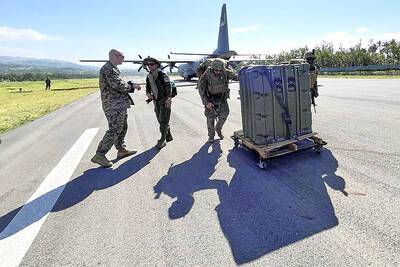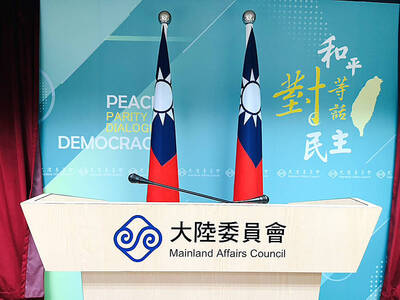Former Taipei mayor and Chinese Nationalist Party (KMT) Vice Chairman Hau Lung-bin (郝龍斌) and other senior party members are publicly differing with KMT Chairwoman Hung Hsiu-chu’s (洪秀柱) interpretation of the so-called “1992 consensus.”
The “1992 consensus” — a term former Mainland Affairs Council chairman Su Chi (蘇起) admitted to making up in 2000 — refers to a supposed understanding between the KMT and the Chinese government that both sides acknowledge there is “one China,” with each side having its own interpretation of what “China” means.
The KMT national congress on Sept. 4 adopted a new policy platform that left out the phrase “one China, with each side having its own interpretation.”
Hung’s amendment to the platform — she says that the “1992 consensus” already contains the idea of “different interpretations” — has been seen as an attempt to move closer to “one China, same interpretation.”
Speaking with members of the US Congress on Sunday in Washington, former premier Hau Pei-tsun (郝柏村) and former National Security Council secretary-general Hu Wei-chen (胡為真) said the idea of there being “one China with different interpretations” is a prerequisite of the “1992 consensus.”
In an earlier interview with Voice Of America, the former premier said that his understanding of the consensus was that there is “one China, with different interpretations,” adding that “the so-called ‘one China’ means the ‘one China’ principle, and that ‘different interpretations’ is that mainland is the People’s Republic of China [PRC] and we are the Republic of China [ROC].”
Former vice president Wu Den-yih (吳敦義) and Hau Pei-tsun’s son, Hau Lung-bin, voiced similar opinions last weekend at the annual meeting of the Taiwan Benevolent Association of America in Boston, Massachusetts, where they spoke about the “1992 consensus” and the associated concept of “one China with different interpretations.”
Wu said that “one China” is inextricably tied to the notion of “different interpretations” and that it is impossible to have only one interpretation or ambiguous interpretations of what “China” means.
“Of course ‘one interpretation’ of China would make everyone happy, but do you think Beijing will accept one nation under the Republic of China constitution?” Wu said.
Hau Lung-bin said that any understanding of the “1992 consensus” necessitates acceptance of the idea of different interpretations of what “China” means, leading observers to speculate that he and Wu were joining hands to take on Hung.
However, KMT Culture and Communications Committee director Chow Chi-wai (周志偉) said the peaceful political platform adopted by the KMT congress is the “1992 consensus” itself, which he said strengthens the importance of the ROC Constitution.
Allowance for different interpretations of what “China” means is part of the tacit understanding that came out of the 1992 meeting that led to the consensus and that therefore this understanding remains in place whether explicitly stated or not, Chow said.

LOOKING NORTH: The base would enhance the military’s awareness of activities in the Bashi Channel, which China Coast Guard ships have been frequenting, an expert said The Philippine Navy on Thursday last week inaugurated a forward operating base in the country’s northern most province of Batanes, which at 185km from Taiwan would be strategically important in a military conflict in the Taiwan Strait. The Philippine Daily Inquirer quoted Northern Luzon Command Commander Lieutenant General Fernyl Buca as saying that the base in Mahatao would bolster the country’s northern defenses and response capabilities. The base is also a response to the “irregular presence this month of armed” of China Coast Guard vessels frequenting the Bashi Channel in the Luzon Strait just south of Taiwan, the paper reported, citing a

A total lunar eclipse, an astronomical event often referred to as a “blood moon,” would be visible to sky watchers in Taiwan starting just before midnight on Sunday night, the Taipei Astronomical Museum said. The phenomenon is also called “blood moon” due to the reddish-orange hue it takes on as the Earth passes directly between the sun and the moon, completely blocking direct sunlight from reaching the lunar surface. The only light is refracted by the Earth’s atmosphere, and its red wavelengths are bent toward the moon, illuminating it in a dramatic crimson light. Describing the event as the most important astronomical phenomenon

UNDER PRESSURE: The report cited numerous events that have happened this year to show increased coercion from China, such as military drills and legal threats The Chinese Communist Party (CCP) aims to reinforce its “one China” principle and the idea that Taiwan belongs to the People’s Republic of China by hosting celebratory events this year for the 80th anniversary of the end of World War II, the “retrocession” of Taiwan and the establishment of the UN, the Mainland Affairs Council (MAC) said in its latest report to the Legislative Yuan. Taking advantage of the significant anniversaries, Chinese officials are attempting to assert China’s sovereignty over Taiwan through interviews with international news media and cross-strait exchange events, the report said. Beijing intends to reinforce its “one China” principle

The presence of Taiwanese politicians at China’s military parade tomorrow would send the wrong message to Beijing and the international community about Taiwan’s sovereignty and democracy, a national security official said yesterday. China is to hold the parade tomorrow to mark the 80th anniversary of Japan’s surrender in World War II. By bringing together leaders of “anti-West” governments such as Russia, North Korea, Iran and Belarus, the parade aims to project a symbolic image of an alliance that is cohesive and unbending against Western countries, the national security official said, speaking on condition of anonymity. Former Chinese Nationalist Party (KMT) chairwoman Hung Hsiu-chu